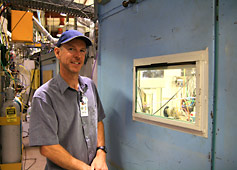
Handy Links
SLAC News Center
SLAC Today
- Subscribe
- Archives: Feb 2006-May 20, 2011
- Archives: May 23, 2011 and later
- Submit Feedback or Story Ideas
- About SLAC Today
SLAC News
Lab News
- Interactions
- Lightsources.org
- ILC NewsLine
- Int'l Science Grid This Week
- Fermilab Today
- Berkeley Lab News
- @brookhaven TODAY
- DOE Pulse
- CERN Courier
- DESY inForm
- US / LHC
SLAC Links
- Emergency
- Safety
- Policy Repository
- Site Entry Form

- Site Maps
- M & O Review
- Computing Status & Calendar
- SLAC Colloquium
- SLACspeak
- SLACspace
- SLAC Logo
- Café Menu
- Flea Market
- Web E-mail
- Marguerite Shuttle
- Discount Commuter Passes
-
Award Reporting Form
- SPIRES
- SciDoc
- Activity Groups
- Library
Stanford
Around the Bay
SSRL Experiment Support Group
 The Experiment Support Group is like the veritable NASCAR road crew for visiting researchers at the Stanford Synchrotron Radiation Laboratory: while the researchers drive the experiments, the group keeps SSRL's
X-ray and ultraviolet beam lines running optimally, satisfy any short-notice special requests of users, and quickly solve any problems with beam line operations. Before an experiment starts, the group is in charge of aligning and focusing the beam. During a user change over, when time is of the essence, they deconstruct one experiment and set up the next one in a matter of hours. And, this is all done near a circular track of quickly moving objects.
The Experiment Support Group is like the veritable NASCAR road crew for visiting researchers at the Stanford Synchrotron Radiation Laboratory: while the researchers drive the experiments, the group keeps SSRL's
X-ray and ultraviolet beam lines running optimally, satisfy any short-notice special requests of users, and quickly solve any problems with beam line operations. Before an experiment starts, the group is in charge of aligning and focusing the beam. During a user change over, when time is of the essence, they deconstruct one experiment and set up the next one in a matter of hours. And, this is all done near a circular track of quickly moving objects.
Need the X-ray beam focused to only a few tens of microns wide to analyze an inter-planetary dust sample? Or has the motorized stage moving your delicate sample of Archimedesí transcriptions suddenly stopped working? Whatever a userís beam line needs are, the Experiment Support Group is up to the challenge.
"Our bottom line," says team lead Bart Johnson, "is users leaving with the highest quality data achievable."
Recently, researchers at SSRL were creating two-dimensional images of slices of the human brain. To get as much spatial resolution as possible, the experimenters needed the focused beam spot at the sample to be as small as possibleóso they called in the Experiment Support Group. Focusing the X-ray beam requires Zen-like patience and skill. As the beam diverges from the source, it is focused by a 1.2 meter long single-crystal silicon mirror 13 meters away. It then hits the sample 23 meters downstream of the source. A member of the group must make miniscule adjustments via the computer-controlled mirror positioner to achieve the best possible focus.
The group was formed out of the X-ray and Vacuum Ultraviolet groups, names by which many SSRL employees still know them. Of the group's four engineers and four technicians, most have been there at least 10 years, and some more than 20.
The group is not only focused on assisting researchers and day-to-day beam line operations, but also on special experiment requirements. They develop new beam line technologies to increase experiment capabilities and reduce experimental error. Projects currently underway include a wide-temperature-range sample stage for X-ray scattering experiments that will both heat and cryogenically cool a sample. This will enable experimenters to continuously collect data for sample temperatures down to 40 degrees Kelvin and up to 570 degrees Kelvin without having to realign the sample. This will save the users time and allow them to take seamless sets of data over a wide range of temperatures.
Charles Troxel, who has been with the group for 23 years, says that being a part of so many experiments is his favorite aspect of the job: "Right now, beam line 6-2 is analyzing comet dust, beam line 10-2 is scanning human brains and just last week was looking at fossilized dinosaur skin. We get to be a part of this!"
—Calla Cofield, SLAC Today, June 10, 2008
Above image: Experiment Support Group Team Lead Bart Johnson stands outside of the powder diffraction station at Beamline 2-1.